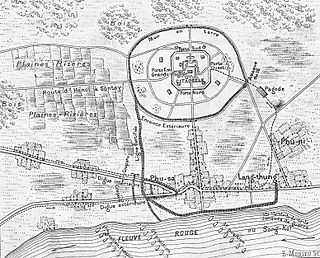 W
WThe Battle of Cầu Giấy or Paper Bridge, fought on 19 May 1883, was one of the numerous clashes during the Tonkin Campaign (1883–86) between the French and the Black Flags. A small French force under the command of capitaine de vaisseau Henri Rivière attacked a strong Black Flag defensive position near the village of Cầu Giấy a few miles to the west of Hanoi, known to the French as Paper Bridge. After initial successes, the French were eventually enveloped on both wings, and were only with difficulty able to regroup and fall back to Hanoi. Rivière and several other senior officers were killed in the action.
 W
WThe Battle of Gia Cuc, fought on 27 and 28 March 1883, was a battle in the Tonkin Campaign between the French and Vietnamese, during the period of undeclared hostilities that preceded the Sino-French War.
 W
WThe Battle of Palan was one of several clashes between the Tonkin Expeditionary Corps and Liu Yongfu's Black Flag Army during the Tonkin campaign (1883–1886). The battle took place during the period of increasing tension between France and China that eventually culminated in the Sino-French War.
 W
WThe Battle of Phu Hoai was an indecisive engagement between the Tonkin Expeditionary Corps and Liu Yongfu's Black Flag Army during the early months of the Tonkin campaign (1883–1886). The battle took place during the period of increasing tension between France and China that eventually culminated in the Sino-French War.
 W
WThe Battle of Thuận An was a clash between the French and the Vietnamese during the period of early hostilities of the Tonkin Campaign. During the battle a French landing force under the command of Admiral Amédée Courbet stormed the coastal forts that guarded the river approaches to the Vietnamese capital Huế, enabling the French to dictate a treaty to the Vietnamese that recognised a French protectorate over Tonkin. The French strike against the Vietnamese in August 1883, sanctioned by Jules Ferry's administration in Paris, did more than anything else to make a war between France and China inevitable, and sowed the seeds of the Vietnamese Cần Vương national uprising in July 1885.
 W
WThe Capture of Nam Định, a confrontation between the French and the Vietnamese, was one of the early engagements of the Tonkin Campaign (1883–86). In a brief campaign in the last week of March 1883, Commandant Henri Rivière captured the citadel of Nam Định, the second-largest city in Tonkin, with a flotilla of gunboats and a battalion of marine infantry.
 W
WAnatole-Amédée-Prosper Courbet was a French admiral who won a series of important land and naval victories during the Tonkin Campaign (1883–86) and the Sino-French War.
 W
WGeneral Jacques Charles René Achille Duchesne was a 19th-century French military officer. He was born at Sens and entered Saint-Cyr in 1855, aged 18, and became a lieutenant in 1861.
 W
WHenri Laurent Rivière was a French naval officer and a writer who is chiefly remembered today for advancing the French conquest of Tonkin in the 1880s. Rivière's seizure of the citadel of Hanoi in April 1882 inaugurated a period of undeclared hostilities between France and Dai Nam that culminated one year later in the Tonkin campaign (1883–1886).
 W
WThe Sino-French War, also known as the Tonkin War and Tonquin War, was a limited conflict fought from August 1884 through April 1885. There was no declaration of war. Militarily it was a stalemate. The Chinese armies performed better than in other nineteenth-century wars and the war ended with French retreat on land. However, one consequence was that France supplanted China's control of Tonkin. The war strengthened the dominance of Empress Dowager Cixi over the Chinese government, but brought down the government of Prime Minister Jules Ferry in Paris. Both sides were satisfied with the Treaty of Tientsin. According to Lloyd Eastman, "neither nation reaped diplomatic gains."
 W
WThe Sơn Tây campaign was a campaign fought by the French to capture the strategically important city of Sơn Tây in Tonkin from Liu Yongfu's Black Flag Army and allied contingents of Vietnamese and Chinese troops. The campaign was one of several clashes between the Tonkin Expeditionary Corps and the Black Flag Army during the Tonkin campaign (1883–1886), and took place during the period of undeclared hostilities that preceded the Sino-French War.
 W
WThe Tonkin campaign was an armed conflict fought between June 1883 and April 1886 by the French against, variously, the Vietnamese, Liu Yongfu's Black Flag Army and the Chinese Guangxi and Yunnan armies to occupy Tonkin and entrench a French protectorate there. The campaign, complicated in August 1884 by the outbreak of the Sino-French War and in July 1885 by the Cần Vương nationalist uprising in Annam, which required the diversion of large numbers of French troops, was conducted by the Tonkin Expeditionary Corps, supported by the gunboats of the Tonkin Flotilla. The campaign officially ended in April 1886, when the expeditionary corps was reduced in size to a division of occupation, but Tonkin was not effectively pacified until 1896.
 W
WThe Tonkin Expeditionary Corps was an important French military command based in northern Vietnam (Tonkin) from June 1883 to April 1886. The expeditionary corps fought the Tonkin Campaign (1883–86) taking part in campaigns against the Black Flag Army and the Chinese Yunnan and Guangxi Armies during the Sino-French War and the period of undeclared hostilities that preceded it, and in important operations against Vietnamese guerrilla bands during the subsequent 'Pacification of Tonkin'.